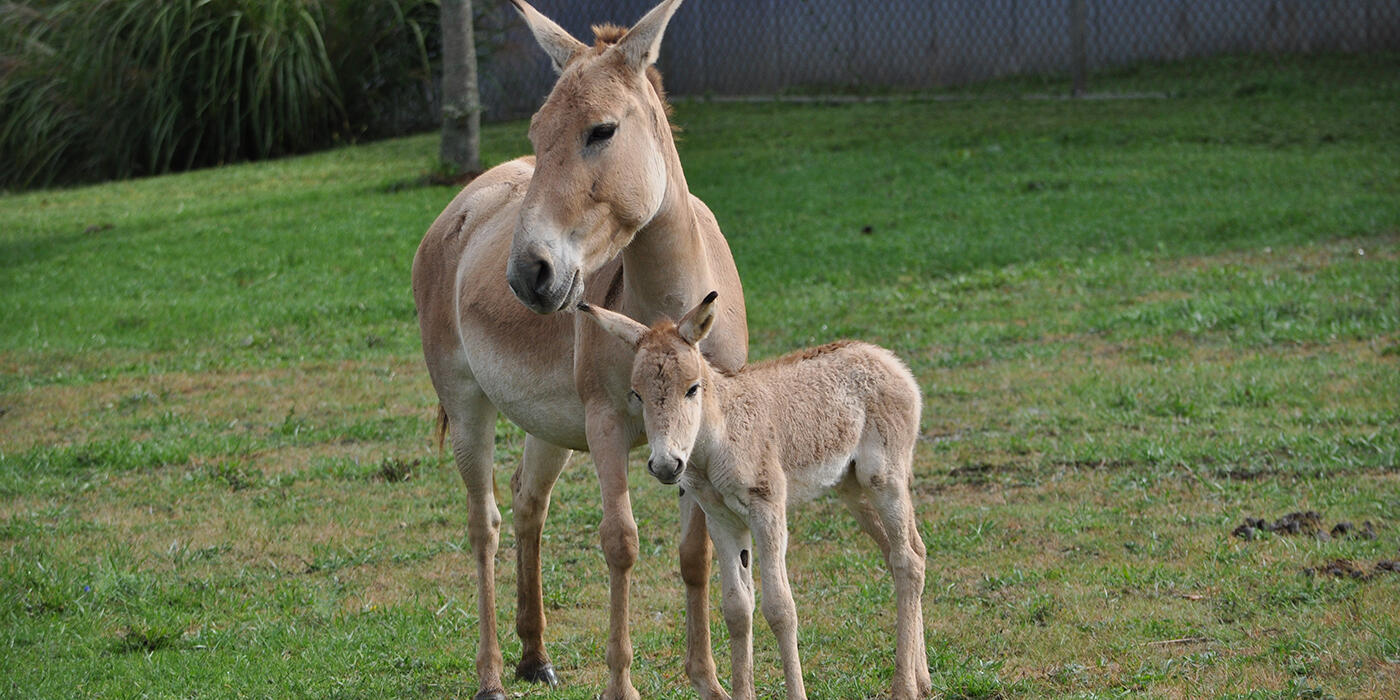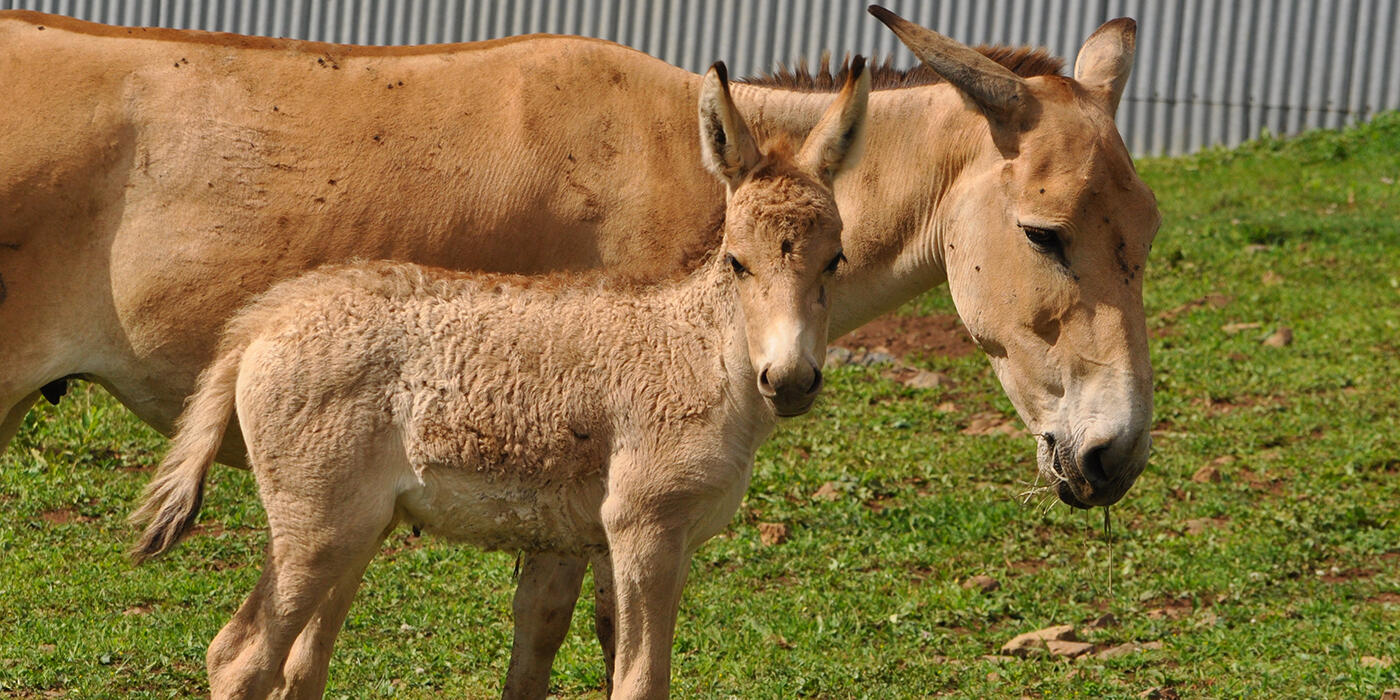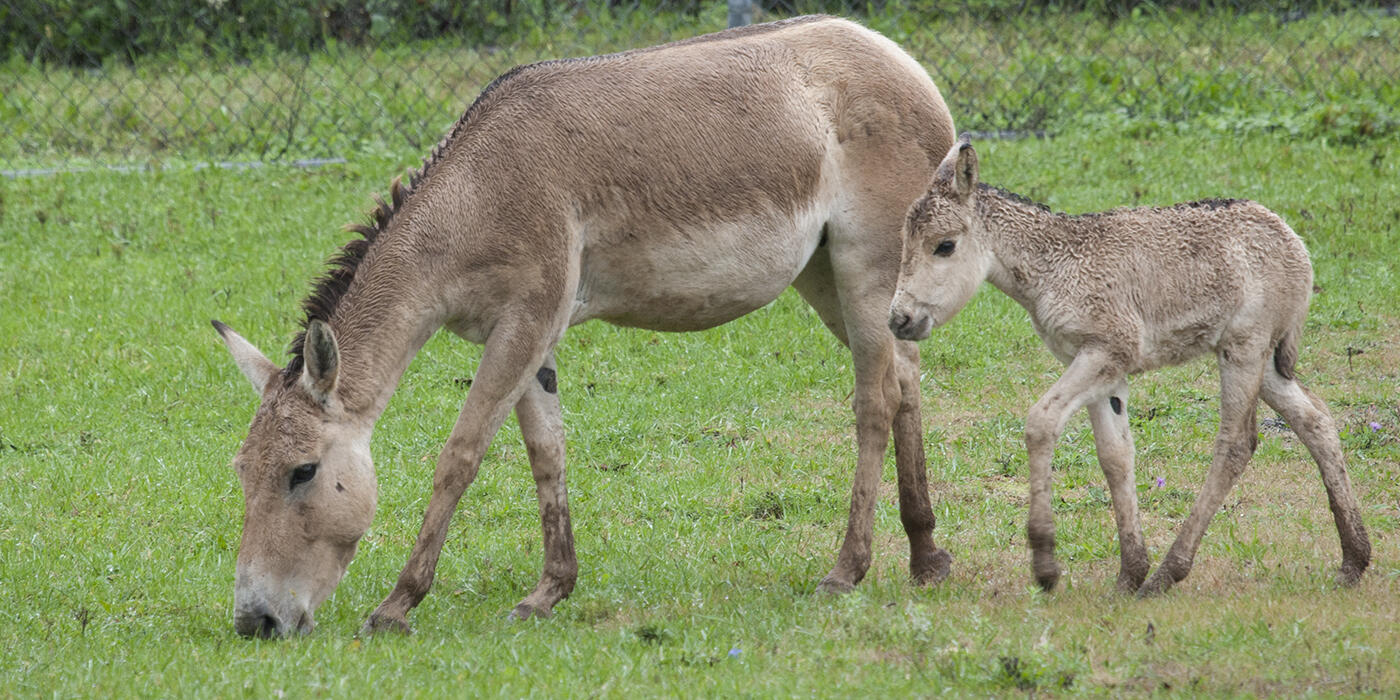Physical Description
The Persian onager is slightly smaller with a paler coat than other wild asses. It has a pale, sandy-red colored coat with a light brown dorsal stripe. The dorsal stripe has two surrounding white strips that blend into the paler hind quarters. In addition to the dorsal stripe, onagers also have a shoulder stripe.
They have a short brown mane that is 2 to 3 inches tall and stands up straight. Their tails are shorter than horses with only a small tuft of hair at the end. The flanks, back and underside of onagers are white. In the winter, the coat grows longer, turns grayer and the white areas become more defined. Males and females differ only slightly outwardly, with males being only slightly larger.
Size
Male Persian onagers stand around 4.9 feet (1.5 meters) tall at the shoulder and are about 6.5 feet (2 meters) long. They weigh about 440 to 575 pounds (200 to 260 kilograms). Females are just slightly smaller than males.
Native Habitat
Onagers are known to inhabit mountain steppes, semi-desert or desert plains from Mongolia to Saudi Arabia and as far north as southern Russia and Kazakhstan. Some also inhabit northwestern India and Tibet. They have been reintroduced in Mongolia and Iran. However, this particular subspecies is found in Iran’s semi-desert habitat.
These barren deserts are a harsh environment and receive very little rainfall each year. The Persian onager’ s population is estimated to be between 600 and 700 individuals living in two protected habitats in Iran. The largest population of Persian onagers is found in Turan National Park in Semnan.
Lifespan
The lifespan of an onager in the wild is undocumented but is reported to be approximately 40 years.
Communication
The onager has strong senses, including an extremely keen sense of smell. Like other members of the horse family, onagers have vocal, tactile and chemical communication. In addition, visual signals may be important.
Food/Eating Habits
Onagers are herbivores that feed on the scarce plant life in the desert. Foods include grasses, bushes, herbs and foliage. Onagers receive most of their water from their food.
However, due to the harsh conditions that the desert presents, onagers must stay within 12 miles (20 kilometers) of a water source. Grazing time for onagers is usually during the cooler parts of the day, such as morning and evening.
Social Structure
Territorial defense social systems seem to be the most common for onagers. A male guards a prime territory, and groups of females migrate between guarded territories, depending on their habitat and mate preferences. Some females remain in one guarded territory while others choose to move among several territories.
Immature males sometimes form all-male groups before reaching breeding age. However, scientists have also observed onagers forming harem groups. In a harem-style social system, a dominant male guards a group of females from other males.
Reproduction and Development
Asiatic wild asses are known for two breeding behaviors. In the first, females pass through male-dominated territory during mating season. The males that keep the best territory are the most dominant. In the second behavior, one dominant male guards a harem of females with which he breeds.
These differences in breeding behaviors may change across subspecies or could be due to other factors, such as climate change and habitat loss that would result in altered behavior. Little is known about the differences between the subspecies of Asiatic wild ass, but onagers are thought to be polygynous. During mating season in mid-June, stallions fight each other for mating rights.
Females have a short estrus period of 3 to 5 days. Gestation length is approximately 365 to 368 days; mares leave the herd to give birth in a safe place. A single foal is born and is able to run shortly after birth. The mare and foal will quickly join the herd where the mother then ensures the foal's safety for two years.
Young onagers become independent around two years of age. Females are sexually mature around the age of 2, but males mature about a year later. Onagers are seasonal breeders, breeding every other year. Most births occur between April and Sept. in managed populations in North America.
However, foals can be born at any time of the year. In the wild, foals have a 50 percent survival rate, whereas females born in managed populations have a 24 percent and males a 38 percent chance of survival.
Conservation Efforts
Even after the most recent reintroduction, the Persian onager population has still experienced a decline of at least 28 percent over the last three generations. In 2007, a census estimated a total of about 600 individuals living in two separate and genetically isolated populations in the small, geographically separated protected areas of Touran and Bahramgor.
An additional five individuals were introduced into Saudi Arabia in 2003, but this managed population has not expanded since. The global managed population is fewer than 1,000 animals, including fewer than 30 in North American zoos. The rapid infrastructure development and the associated influx of people in large parts of the species range could quickly result in the re-emergence of old threats, such as increased competition with livestock for water and pasture or high poaching levels.
Furthermore, if not carefully designed and mitigated, linear infrastructure, such as roads, railways and canals, are likely to result in high mortalities if onagers are impeded in their long-distance movements and become cut off from important resources or refuge areas.
Threats to Asiatic wild asses stem from illegal hunting for meat, hides and fat (which, like liver, is believed to have medicinal properties), competition with humans and livestock over water and pasture use, and crop depredation. Other threats are habitat loss as a result of human settlement and cultivation, overgrazing and degradation, and limited access to open water sources. The mere presence of people and their livestock at water points can limit or block access for wild asses.
Wild asses have become largely confined to semi-desert and desert areas with a high variability in water and pasture availability. To cope with this unpredictable environment and track the scarce resources available, wild asses must have access to large tracts of land. This is particularly true in times of weather extremes, when they need to outrun summer droughts or extreme winters.
Although protected areas may provide important refuges, long-term conservation of wild asses will have to happen on the landscape scale. New planning tools are needed, like the “planning for a moving target” approach suggested for Saiga (Saiga tatarica) in Kazakhstan.
Small, isolated populations are demographically and genetically vulnerable and prone to extinction, particularly in habitats with frequent environmental extremes. Small and localized populations also have limited resilience to disease outbreaks or climate change.
Persian Onagers at the Smithsonian Conservation Biology Institute
The first-ever artificial insemination of stored sperm of any wild equid was with this species and resulted in two Persian onager foals at The Wilds, a conservation center in Ohio, in collaboration with experts from the Smithsonian Conservation Biology Institute.
Then, on September 7, 2011, a foal was born at SCBI. SCBI continues to partner with The Wilds to produce a large population of onagers.
Help this Species
Support organizations like the Smithsonian’s National Zoo and Conservation Biology Institute that research better ways to protect and care for this animal and other endangered species. Consider donating your time, money or goods.
Share the story of this animal with others. Simply raising awareness about this species can contribute to its overall protection.
Smithsonian's National Zoo and Conservation Biology Institute. (n.d.). Persian onager. Retrieved October 20, 2025, from https://nationalzoo.si.edu/animals/persian-onager
Animal News

7 Spooktacular Animal Facts for Halloween ›

Meet the Orangutans Living at the Smithsonian’s National Zoo ›



